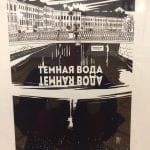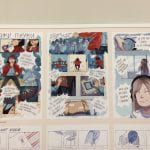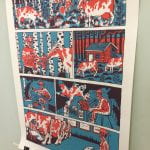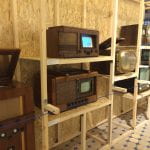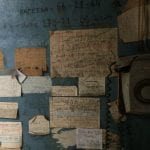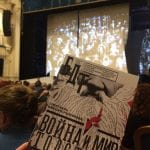Artistic Revolution
Saint Petersburg acted as the capital the country for 2 centuries, where aristocracy full of military and government officials did their jobs and flirted at balls, and artists and musicians all flocked there too. Best international talents also coursed there at the request of the aristocracy stuck in this swamp and needing some beauty – the designers of SPb were Italians, mostly, with statues for people like Francesco Rastrelli, designer of the Winter Palace, Carlo Rossi and his son, Francesco Rastrelli. For this reason, SPb feels so much more like a European city than a Russian one – no medieval walls, no simple churches, but rather European streets and elaborate facades. Plaques and statues of them stand all around the city as a reminder that the international spirit of Saint Petersburg started at the very beginning.

Swan Lake at the Mariinsky Theater
Most major Russian cultural institutions are located here, and most are within walking distance of each other – the Russian museum (of art), the Hermitage, the modern museum called Erarta.

A portrait of Lermontov from the Library of Lermontov on Liteiniy. His busts, portraits, writings sprout from every corner of the actually-in-use library. To have this literary giant be the name of a series of libraries — it’s inspiring to work in, to say the least.
The real beauty is in the streets – in historical writers’ apartments, in stone placards with the profiles of famous the poetics of the street. Most areas of the city have a literary character or scene associated with them. I live 15 minutes from Sennaya Ploshad’, the famous central location from Dostoyevsky’s Crime and Punishment. Pushkin owned many apartments all over the city – Smolny is located on the same street as one of them.

Museum of SPb Print — this is the room where Lenin and his team of editors wrote “Pravda” before the revolution
The poetry of those streets is amazing – cobblestone, amazing facades, buildings with a visible history. Not everything is restored, so we can see the age. Up close to the Neva and the canals, the building facades are crumbled and deteriorated up to 2 feet off the ground. When these symbols of time are restored, as happened with the Summer Garden, the 200-year-old marble statues, covered in grime and black remnants in those little dips and valleys on their bodies, were suddenly replaced by shining new marble-dust copies, shaped into the previous gorgeous forms, but without any of the character of the older forms. The funny thing is that the people that we glorify who saw these statues in their lifetime – they were new for them. They didn’t have the character of an older being looking at a newer world, but rather the freshness of something new in place of where there was nothing before.
- “Dark Water” – a comic about the SPb canals.
- One of the entries to the “report” content at Boom-Fest 2016, the visual graphics festival.
- A contemporary view on agricultural Russian life.
Real SPb is looking deeper into the courtyards and into the small doorways – metro stations and their mosaics, from Admiralteiskaya with its beautiful murals of Peter the First and his armada, to Sportivnaya and its glorification of the Soviet athletic lifestyle in a Greek, Olympic style.
- Comments on Soviet culture, as shown in contemporary art museum Erarta.
- Mosaics at metro station Sportivnaya (literally, “Sporty”)
- I ducked into a museum of television and saw the first Soviet televisions and they were rad.
Street art is huge, especially in those courtyards. A huge active and entrepreneurial creative class of teens and young adults create amazing strange works of art on the typical SPb walls with their eagerness to do new things. Hipsterism here is big. In its own Russian way. The wave rolled into SPb in 2014 with cute cafes, vintage photography, empty frames on colored walls, minimalism. Beanies. Platform shoes. They’re everywhere. From Art Loft Project Etazhi and its narrow staircases and cute trinket shops and alternative galleries to and the restaurant and bar street Rubenstein and each a little different and at different levels of hipster.
- Part bookstore, part coffeeshop, overrall v cute
- This is half tea shop and half normal grocery store.
- Steps of a wine bar on V.O. near the main buildingg of SPbGU
- How did they get up there??
- Casual graffiti near the Fontanka
This hipster undertone of current SPb proceeds from its rich alternative history: Soviet punk rockers flocked to the staircase space of Rotunda in the 1980s, wrote rebellious music, decorated the walls with graffiti. The group Kino started there. A couple streets over on Pushkinskaya-10 in the 1980s, the deteriorating apartment complexes stood vacant since the city had no money to renovate them, but just enough to relocate all its residents. A bunch of artists, musicians, filmmakers, moved into the apartments and did their jobs – creating. That union of artists got media attention, a bunch of press, and a problem when the SPb government got money again and wanted to get the artist squatters out of there. They went into negotiations to keep the creative space – the artists had their gas and electricity cut, but they decided that no, this was central SPb and they owned this space. In the end, all of the apartment complexes were renovated and all but one were vacated, with the last one left for the artists as an art center. Said art center is now the only independent non-governmental artistic institution in SPb, and I do translations and lead tours for it. Those artists still inhibit that space today.

Museum of Russian Rock at Pushkinskaya-10. Visitors can play on museum guitars (that were played by the people whose posters adorn the walls). Pushkin, That Russian Poet, Our Everything, looks over the “Punk’s Not Dead” flag.
At the opening of the gallery at the Noncomformist Museum of Art, I met with an artist who then invited me to a life drawing session at his studio. The next day I trekked to his studio – the highest story of a residential building without an elevator, a series of artists’ studios, a hallway covered with frames and forgotten canvases, a bathroom that shouldn’t be there because the top floor was and how much fun that was – pics from that rad experience.
https://www.youtube.com/watch?v=2yKuChMvviU
- Years of artists have been using this studio space.
- And their remnants are everywhere.
Another huge element is theater and theater life – SPb has a very conservative theatrical style, with old lexicon and a traditional approach to the stage, along with a more experimental side. Ballet and opera reign at the Mariinsky, the most famous theater of SPb. I’ve had amazing experiences with a new, high-brow take on “Groza,” an experimental folktale take on the short story, and absolutely horrendous ones with “Demon of Onegin,” a what-if-demons-were-involved musical version of the poetic novel. And about that one – the Demon one — Ive never seen a worse show. In my life.
- “Groza” (Thunder). I realize I have only spoken about BDT and the Mariinsky but there are other theaters I’ve been to in SPb!
- A contemporary adaption of “War and Peace.”
- At the Mariinsky!!
I also saw a live show of Projector Paris Hilton – which sounds odd, I know, but hear me out, I need to explain what that is. PPH is a (political) satirical comedy group made up on four solidly famous and influential Russian media heavyweights – Ivan Urgant (actor, comedian, host of Russia’s first real late-night show), Sergei Svetlakov (actor, comedian), Garik Martirasian (actor, host, producer), and Alexandr Tsikalo (actor, producer). This was originally a show on Perviy Kanal from 2008-2012 in which these four guys sat around a table with a bunch of newspapers and joked about the stories in them. They went off the air at a pretty coincidental time and went their separate ways, but in October, four years later, they joined together for a live show in which they did the exact same thing, except with slyer digs than those they did before 2012. Their wit, incisive comments, optimistic humor were refreshing – no matter what, intelligent, funny people who see through bullshit still exist, and a sold-our concert hall was ready to hear what they were saying.

I remember leaving that performance that night and walking to the bus stop. All around me was a typical SPb look of graffiti tags on crumbling facades with quiet sad Soviet-looking streetlamps casting that dull yellow tone onto the forgotten concrete. Near the stop I saw the most iconic SPb scene so far: a couple hipster-looking teens sitting, smoking on palace steps and leaning on graffiti’d columns. I rode to my host mom that night with a mind going wild from the digging jokes and optimistic creativity of the PPH guys, thinking about music, about creation, about humor, about what we take with us when we leave. The tired bus carried me through the streets of SPb, through that weird blend of old and new, creation among destruction, of poetry.
[youtube https://www.youtube.com/watch?v=sTUp134Vvs4]
